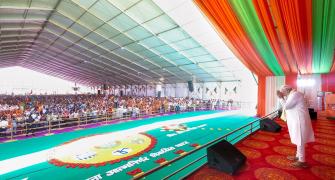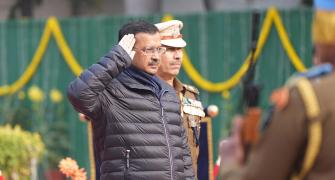In just about a month's time, Mumbai's favourite God, Ganesha, will be coming over for his annual visit. This time around, however, the earthenware idols which are worshipped by millions of devotees in their homes will be different -- many of them will be imported from China.
A couple of years ago, when I read that most of the Christmas trees in the United States households were being imported from China, I was amused.
The imported Ganeshas just go to remind us how similar the two largest democracies in the world are in many ways: Huge fiscal deficits, current account deficits, increasing disparities in income levels, etc. There is, of course, one major difference: The US dollar is still the world's reserve currency.
Ganesha idols are only a very small part of the Indo-Chinese trade, yet they are indicative of how competitive the Chinese are, even in relatively low-value goods and after factoring in the transportation cost.
A corollary, of course, is the loss of gainful employment, if only seasonal, for thousands of artisans in Pen and other places in the Konkan. Media reports, suggest that a very large number of small and medium enterprises in India, whom the government wants to encourage, are unable to compete with Chinese imports in items as diverse as vacuum pumps, vaccines, electrical and lighting equipments, pipe fittings and flanges, ceramic tiles and furniture (even honey!).
And larger industrial units don't seem to be faring any better in capital goods like plastic-processing machinery, mining and construction equipment, rice-processing machinery and state of the art communication equipment, etc.
A recent Ficci survey has revealed that nearly two-thirds of the businesses reported 'serious injury' due to competition from Chinese imports which are priced 10-70 per cent lower. (Incidentally, is competition from China the reason why manufacturing-inflation is so low?)
Recently, in my professional capacity, I have been engaged in advising several power projects. One common factor -- each of the half-a-dozen projects is based on Chinese power plants.
Apart from this, many Indian companies are looking to establish facilities in China to manufacture for global markets. China is also on the way to threatening India's dominance in even the diamond trade.
To my mind, part of the reason is the consistent exchange rate policy followed by our giant neighbour to the north, in sharp contrast to the erratic policy followed by India.
The recent Economic Survey had this to say about the exchange rate policy: "The foreign exchange rate policy in recent years has been guided by the broad principles of careful monitoring and management of exchange rates with flexibility, without a fixed or a pre-announced target or a band, while allowing the underlying demand and supply conditions to determine the exchange rate movements over a period in an orderly manner. Subject to this predominant objective, the Reserve Bank of India's intervention in the foreign exchange market has been driven by the objectives of reducing excess volatility, maintaining adequate level of reserves, and developing an orderly foreign exchange market".
Incidentally, we could easily beat Alan Greenspan in saying a lot without conveying anything!
Besides, is the policy, as articulated, true? Take, for example, the contention that it allows 'exchange rate movements in an orderly fashion', and is 'driven by the objective of reducing excess volatility'.
In 2007, the rupee was allowed to appreciate by 9 per cent in eight weeks. Orderly? After the election results, the rupee moved from 49.53 to 47.92 in one day. Orderly? (I am not including the sharp fall of the rupee in October; the RBI did sell $19 billion without arresting the fall).
To get back to the issue of exchange rates, A Sakthivel, President, Federation of Indian Export Organisations, argued in The Economic Times (May 5, 2009), "We are getting orders in abundance but most of us are unable to meet price targets ... more so due to uncertainties on the exchange front".
He has also claimed that at least 500,000 jobs have been lost in export industries. Not surprisingly, the biggest falls have come in labour-intensive industries like gems and jewellery, handicrafts, carpets, textiles, clothing, etc.
One worry is that, in the absence of a consistent, credible exchange rate policy, aimed at a competitive exchange rate, the demand created by the huge fiscal stimulus/deficit will only help Chinese exporters instead of creating domestic jobs (another parallel with the US?).
Incidentally, I found the chapter on the external sector in the Economic Survey more a collection of data with little economic analysis on, for instance, issues like the contribution of exports to GDP growth, the employment created, the impact of the sharp fall in exports which has now continued for the eighth successive month, the elasticity of exports to the exchange rate policy, the increasing competition from imports to SMEs, etc.
Critics of managed exchange rates (they describe them as 'manipulated' exchange rates) always point to the cost of intervention. Few discuss or analyse the far bigger costs of non-intervention in terms of lost output, jobs, and their impact on the fiscal balance.








